
 |
How To Take In flight Shots
Greetings fellow Fotografers.
Some folks have asked me how I do flying shots. Well, it's a secret actually. I've developed a way to bring my figures and vehicles to life, ask them politely to pose for me, then I return them to toy form. Not buying that, huh? OK, it's actually very simple and I hope this little tutorial will help you guys out. There are several ways of achieving flying shots, but I'm going to tell you about the techniques I use. I actually use a couple different ones, depending on what I'm going for. The first thing you will definitely need is some kind of Photo Editing software. I use Adobe PhotoDelux Home Addition, recommended to me by the master himself...The Outrider, and Picasa. I've found the Adobe PhotoDelux on eBay for only a few bucks. It's very easy, simple and not too difficult to use. Cyko Scot of the Colorado Cykos sent me PhotoShop 7. I haven't had a chance to use it yet, but once I do, I'll let you know how it works. Picasa is a free download from the interweb. It has some decent uses, but I'd definitely recommend getting a professional program of some kind. The next thing you'll need is string and wire hangers. I've also found fishing line to be an awesome use as well, especially for some of the heavier planes and helos, plus it's clear and not as obvious if you can't edit it out. The third thing you'll need is patients. I personally like to take pictures of my flying aircraft outside. I like having natural lighting and shadows on my subject. I've taken pictures on sunny days, overcast days, at sun up, sun down, all kinds of lighting conditions. Some of the folks on this site have shown me pictures of their "in flight" aircraft using pictures taken inside. Some look great, others look like they were taken inside. |
The string/fishing line method: This method is great for fixed wing aircraft, not so much the helicopters. I'll 'splain why momentarily. Find a tree, a balcony or something with an overhang.
The wife will sometimes work, however, the tree or balcony rarely utters the phrase, "Are we almost done, my arm is getting really tired." Cut out a lengthy piece of the line, how long will depend on how high up your overhang is. Basically you want your subject to hang just below your shoulders. Tie a loop in the line at both ends and loop it around the nose and the back end of the plane. Now hang the plane from the overhang. You plane is now "flying." Woo-Hoo! 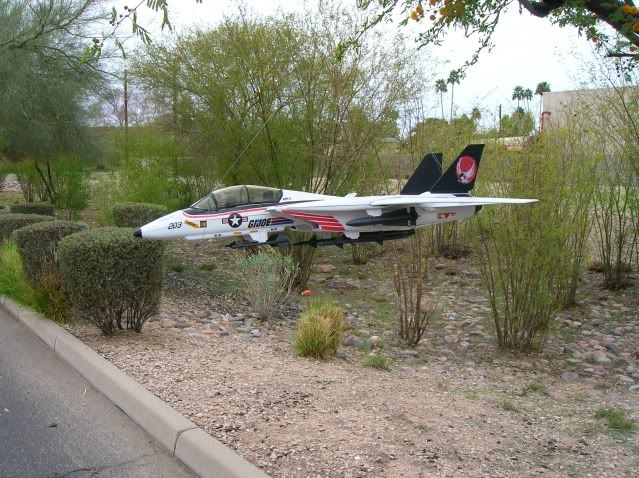 Take pictures of the plane from all kinds of angles. High shots, low shots, side shots, front shots, rear shots, angle shots, tequila shots. Get every possible angle with the shadows of the vertical stabilizer falling on the plane, or a banking shot where part of the plane is lit part isn't. With your plane hanging there, tilt it to one side or the other so it looks like it's flying on knife edge. Then unhook the plane from how ever you've got it hanging and turn it the other direction. Now all the shadows are falling on it from the other side. Again, take shots from all angles. A couple of things to watch out for here. First off, make sure no stray shadows from tree branches or something fall across the plane. Nothing like having your plane in the air with a big ol' tree branch falling across it. The other thing, like almost any photo, make sure of reflection. You'd be surprised how shiny some of these things are and the things they'll reflect, especially if it's the black Night Raven or the dark blue Rattler, lighter objects like your own skin can reflect in the paint of these planes. Have a bit of fun with your plane hanging there. Grab an enemy plane and hold it in your hand. Put the camera near the enemy plane and take pictures of the hanging plane with the enemy plane in frame, then you can have a close up of a dogfight from the enemy plane's point of view. 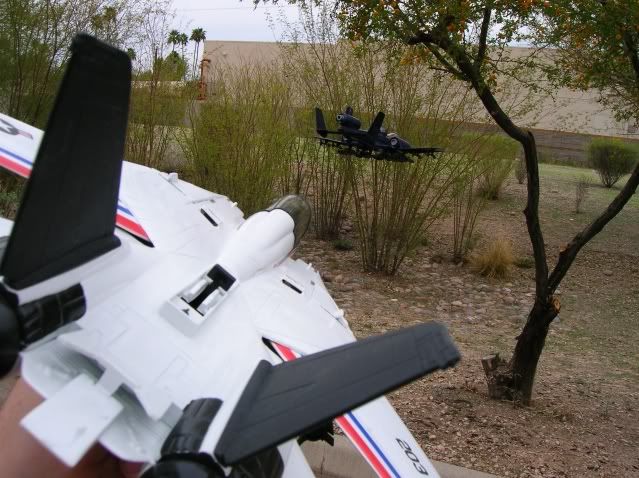 This technique really only works with the fixed wing planes simply because the balance point on the helos is typically the rotors. One thing I'm going to get into shortly is how to achieve "rotor spin" in your shots. If the helo is hanging by the rotor, the effect is harder to achieve. Yes you, in the back, put your hand down, I know what you're going to ask. Stick around and you just might learn something... So yes, you can take a picture of a helo using this technique, but, you'll get better results using my next technique. That covers the string/fishing line method for taking these shots. |
Next is the wire hanger technique. This works best for helos and low flying fixed wing aircraft as well as flying people. No, not like Superman...well, OK, yeah, like Superman, but not. Does that make sense? Yeah, didn't think so. Just go along with me on this one.
You'll need a wire hanger or two and a pair of dykes. (Insert crude lesbian joke here). You'll also need some softer ground for this one. I'll start with heavier planes and helos first. I took two hangers, cut the hook part off using the dykes and straightened them out. I then put two 90 degree bends in them so now they're shaped like a square that's missing a side, or a squared off letter "U." Take the two ends and drive them in the ground at least an inch or so. Then take the second hanger and drive it into the ground about the length of your aircraft away from the first one. You want to try to get the hangers to be at the front and at the back of the plane. 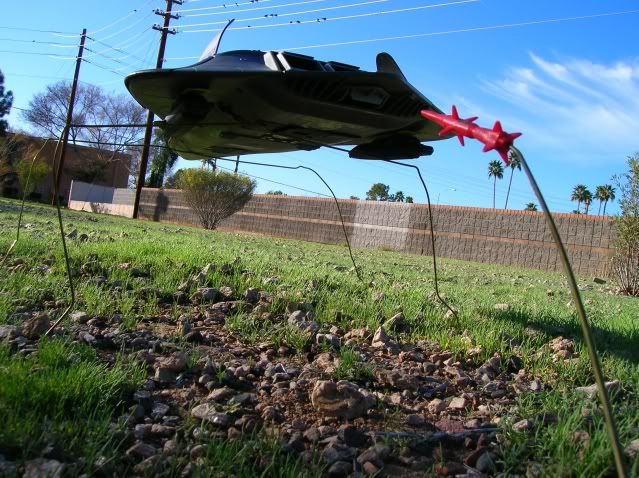 The Night Attack Chopper is very heavy, so it'll need two hangers, as will the Phantom X-19. The Tomahawk doesn't really need two for weight, but it'll need it for length. Once you do this for a while, you'll see what you can get away with. I've used one "U" shaped hanger and one just short bent piece of wire to hold a Tomahawk in place. Using at least two wires is ideal, just for the stability of the plane. Using one "U" shaped wire and the small piece of wire on the Tomahawk gave it a three points stance on the ground and it wasn't going anywhere. Now comes the slightly tricky part that you will adapt to over time as you use this technique more an more. From what angle are you taking the shot? Is it an upshot, a side shot, a down shot? The important thing to keep in mind here the placement of the wire hangers so they don't interfere with the subject. Essentially, the less editing you have to do to the picture, the better off you are. If a small portion of the hanger crosses your line of site to the subject, that's fine, but if it goes across the wind screen, a figure's face, the landing gear and the ground, that's a lot more editing that'll have to be done. I try to use the hangars with a wide stance so that if I'm taking a closer up shot of the subject, the hanger goes out horizontally away from the subject and then out of frame rather than coming from the subject a bit then bending towards the ground. Again, less editing on my part. 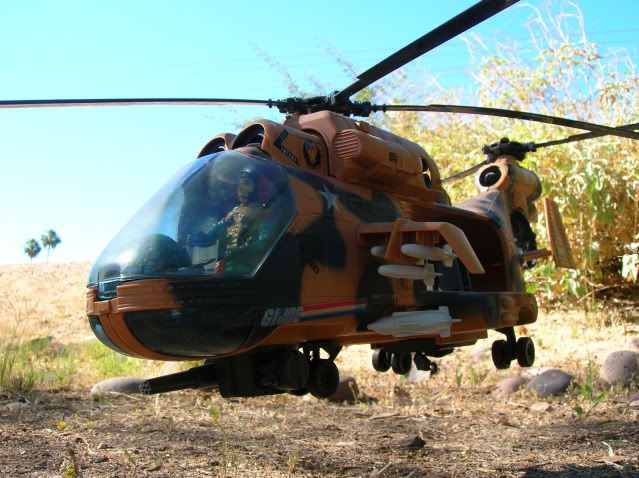 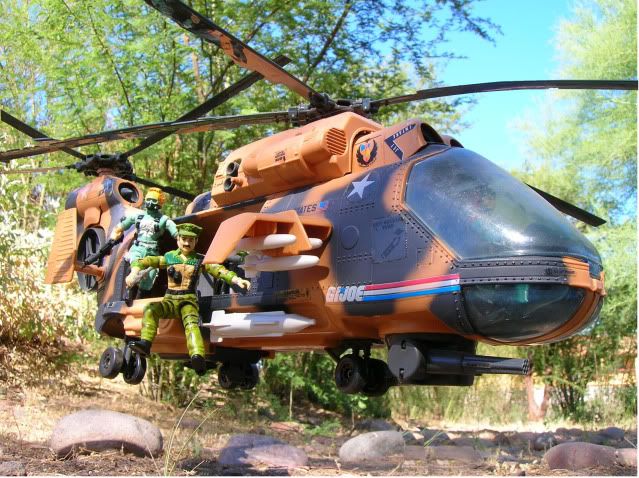 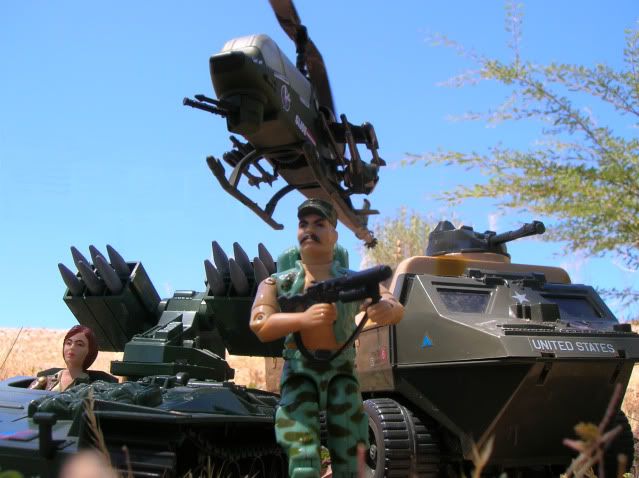 Using the wire hanger trick, you can make things other than helos and airplanes fly. "Like what?" you may ask. If you haven't asked yourself this, please do so now, and wait for a response. You might be interested in what you have to say. One of the iconic images of G.I.*JOE from the beginning, especially when it comes to Stalker, is the jet back. Since the jet pack is something that can be shot low to the ground, the hanger trick works well. Same with Matt Trakker's helo back pack. There are two ways of doing this for a figure. One is to straighten the hanger out, put one end in the ground and put the outer end into the figure's foot hole. This takes patients as you have to balance the figure just right on the tip of the hanger. It may take a few tries. The other, more effective technique is to put a 90 degree bend into the hanger about 3/4 of inch from the end and using this small bent section, form a "U" shape. This acts a kind of clip in which you can slide the figure's ankle. It holds him a little steadier. One thing to keep in mind with using either one of these techniques is that the knees and hips need to be fairly tight since the figure is placing all of it's weight from the hip to the knee to the hanger. 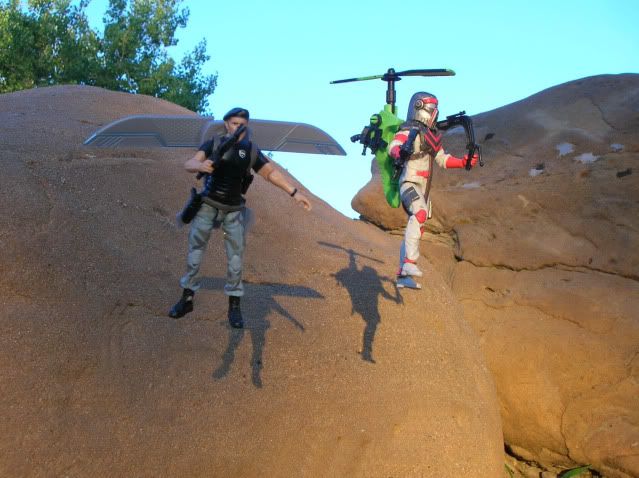 |
Using a smaller piece of hanger and placed in the right part of a figure can make the figure look like they're leaping through the air in a martial arts move.
Here I stuck a small piece of hanger into QK's foot peg hole and positioned him with his other foot against the BAT. Since the BAT is leaning slightly backwards from the kick, he wouldn't stand very well, so what I had to do was place QK's forward foot against the BAT's throat and push the head down over QK'S foot, this way they are actually supporting one another. 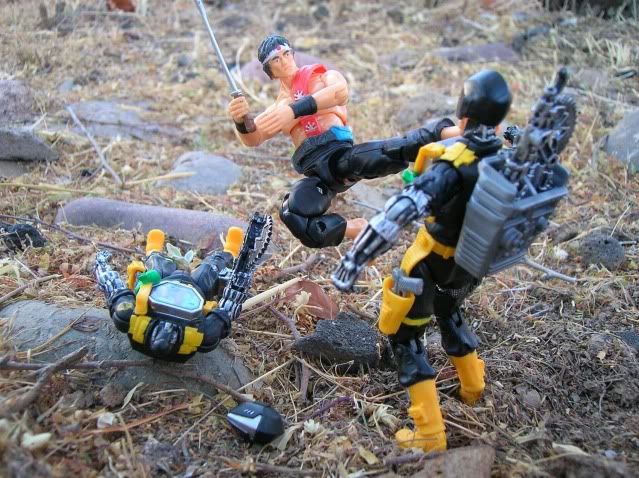 In this shot, the small piece of hanger was (I'm gonna try to make this as clean as humanly possible...) placed in the small, open space between Lady Jaye's thigh and her waist. Anyone who has dirty thoughts about that needs help. I'll be back in a little while. When I first tried this shot, I posed LJ in this position and tried to use some string to hang her from above. This didn't work because there was no place to tie the string that would work with her center of gravity to give her the "in flight" look.  Or being a typical extreme California surfer dude and jumping a motor cycle with a machine gun mounted on it.  Launching a missile from a Stinger... 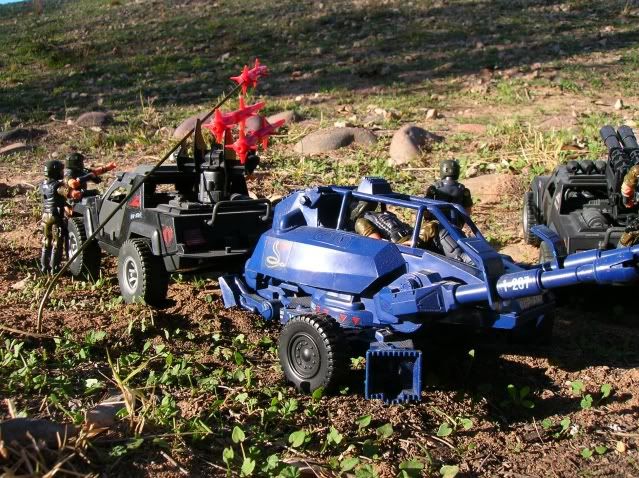 Or better yet, catching some air in a HMMWV. These are partially edited, but you can still see where the hangers were used. These pictures show you that there are almost limitless options on how to use this technique.  I mentioned above that some of the bigger aircraft need two hangers for support. Well, some of the smaller guys can get away with one, like the FANG, the RHINO's helo, Serpentor's Air Chariot, the Flight Pod and the Firebat. Keep this in mind if you're using the one hanger approach with one of the smaller flying machines: they are more unsteady and require some serious patients and a lot of adjusting |
The FANG picture I took recently is an example of a single hanger and a lot of pains taking preparation. It took me about a half an hour to get the stupid thing to stay stable enough for me to photograph. Notice in the picture there is a large chunk of wood at the bottom of the hanger. That was there to stabilize the helo. I drove the hanger into the ground about eight inches and because the hanger was so top heavy, it kept falling over, so I put the wood next to the hanger in the direction the thing would fall and that seemed to work, but, it meant more editing for me to do.
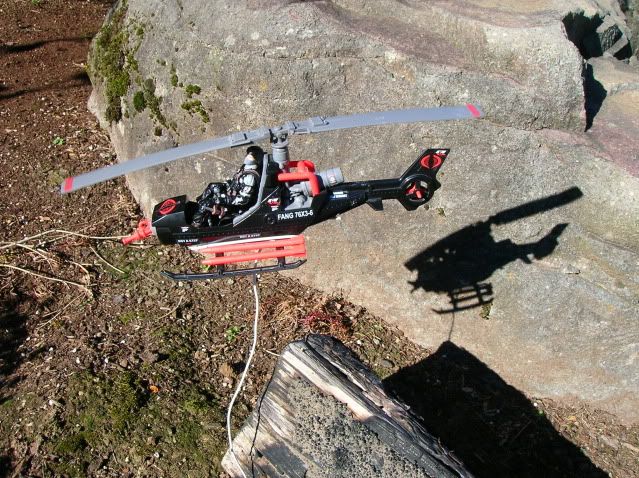 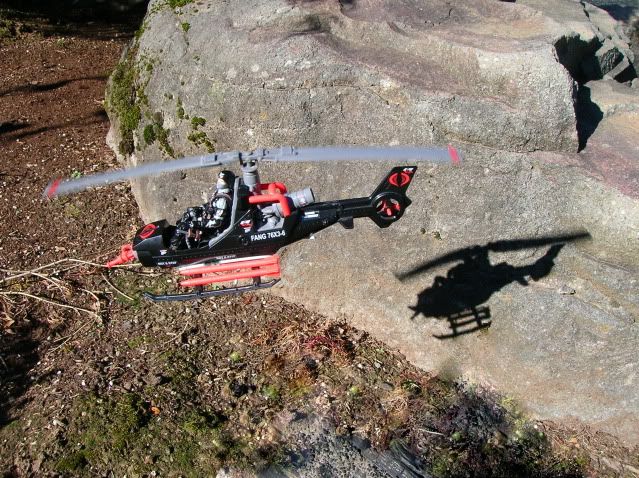 Can you see on the FANG that there is something white between the black fuselage and the red missiles? This is the hanger. Some aircraft have holes in their fuselage where you can stick the wire hanger for stability. The FANG has no such holes, so I had to wrap the hanger around the top of the landing skids then bend it down towards the ground. This still wasn't enough to get the thing to sit atop the hanger easily. I then had to find the FANG's center of gravity and run the hanger down from there. As the hanger is in the ground, you'll see the FANG lean one way or another and you can bend the hanger around the compensate a little, but you'll just have to play around with it before you can get it to work just right. I didn't want to use the two "U" shaped hangers on this one because I wanted the helo to have a bit more altitude then the two hanger system would have really allowed for. These Firebats were really easy. I just shoved the hanger up their tail pipes and let them bend forward. I put the hanger in the ground next to a large rock that was in the direction the hangers were leaning and it kept the two planes off the ground enough that they looked like they were flying really low; the effect I was going for. 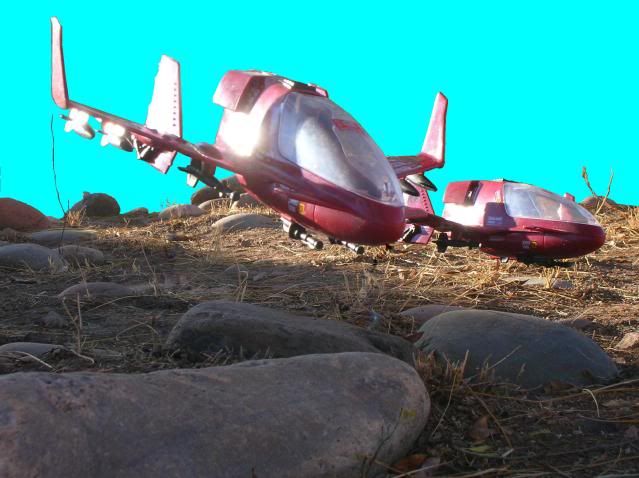 Briefly: Notice the shadow on the rock below the FANG. To me, this sells the shot. This makes it believable that that FANG is really in the air. If the FANG had been super-imposed over the background of the rock and the ground, trying to match the shadow is one of the most difficult things to do. There are times I've seen the shadow left out when it should have been there and for me that takes away from what can be an otherwise great picture. Taking pictures from the ground up, as if you were someone on the ground taking a picture of the FANG flying over head is another great way to sell the shot. |
OK, now the moment you've all been waiting for..."How on God's green Earth do you get those awesome rotor movement shots?!?!" If that wasn't the moment you were waiting for, go sit in the corner and play quietly until this section is over.
This is probably the HARDEST, MOST DIFFICULT and NOT EASY thing you can possible do for a perfect helicopter in flight shot. Are y'all ready for this? (insert cool techno song here) You spin the rotors by hand. Honestly. That's all there is to it. Just spin those suckers like you did when you were a kid playing with these things. So far, I have found that the rotor blades of the NAC, the Dragonfly, the FANG, the RHINO's helo and the bbi MH-6 Little Bird all spin very freely. The Tomahawk...not so much. I think that has more to do with the weight of the rotor blades pulling down on the hub and there's a lot more surface area to cause friction there. I'm not saying it can't be done, it's just a lot more difficult. I did manage to get one picture of my custom Tomahawk with the rotors spinning and it took a few tries as you have to spin both, pick up the camera, frame it up and take the picture. 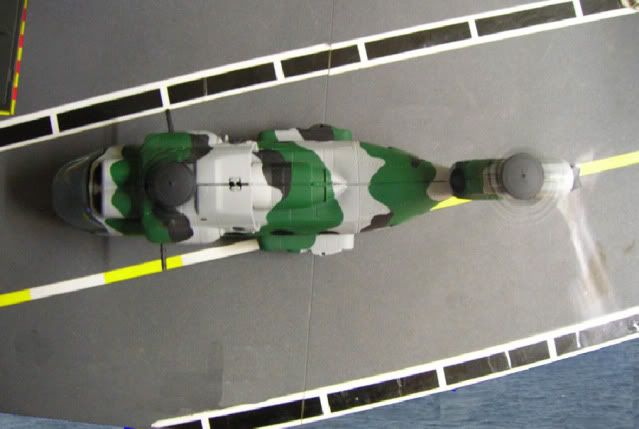 As I said, this is very simple, but here's where you need to take a bit of caution. Again, referring to my recent FANG shot. The FANG was precariously balanced atop that thin hanger. The first time I spun the blades, it caused the hanger to fall over, so I had to hold the FANG in place, spin the blades and then try to take the picture. Usually I can get the blades spinning and get about three or four shots before I have to spin them again. After you spin them, give them a moment to slow down. It makes for a better shot as you can see the blades in you shot with the blur motion. Take note of the above custom tomahawk's rotor spin. I didn't let them slow down before I go the shot and they're barely noticable. This spinning technique is why you can't use the fishing line/string method for shooting aerial shots of the helos. Since the string would most likely be connected to the top of the rotor, you wouldn't be able to spin it. So...now you've got your airplane or helo or jet pack or Karate kicking ninja all set up on their wire hanger, lookin' flawlessly in motion and totally awesome. Now, take your picture. Click...perfect...there it is...oh, but what is that stupid looking piece of wire hanger doing in the shot? It totally ruins it! This is where your editing software come in. Since all photo editing programs are different, I can't elaborate too much here, so I'll tell you what works for me on Picasa and the Adobe PhotoDelux. On something as simple as the FANG picture, I used Picasa to edit out the hanger and the piece of wood. There is a "touch up" tool to use. Move your circle cursor to an area next to the wire and click the mouse. This, in a way, sucks up what ever is in the circle. Now move the mouse over the top of the hanger and click the mouse again. This deposits what ever you sucked up over the top of the hanger. You want to take parts of the back ground from right around the object to be covered so the backgrounds match. This is a lot easier the "busier" the background is with foliage or dirt and rocks and it will blend in better. Using the PhotoDelux, I use a cloning tool. Again, starting at a point right by the object I want to cover so the back ground matches, I clone over the hanger to make it disappear. Where you need to watch using these tools is when you come to straight lines like tree branches or the edge of your plane. If your clone alignment is off the slightest, the lines will be off and noticeable. This takes some practice and some fooling around. You'll probably have to have a few goes at it before you can get it right. Thankfully, that is what ctrl Z (the command, not the photographer) or the undo button are for. Usually your changes will be small enough that they won't really be noticeable. There are a few shots I've taken where I know where the edit is and I can't find it. While I prefer shots of my aircraft to be real and where they are, I will use a superimposed shot from time to time as well. Going back to the shot of my Skystriker hanging by a string in the tree, I will trace the plane in a colour that contrasts with the colour of the plane and make it a wide area around the plane that is this different colour. The reason for this is so that when I do trace the plane with the editing program's cutting tool, the edges are easier to find. Most editing programs nowadays even have a smart selector where you can just run the cursor along the edge of what ever it is you want to cut out and it automatically finds the edges for you. If the colour of the back ground and the colour of the subject are too close, the smart selector will have a hard time finding the edge. 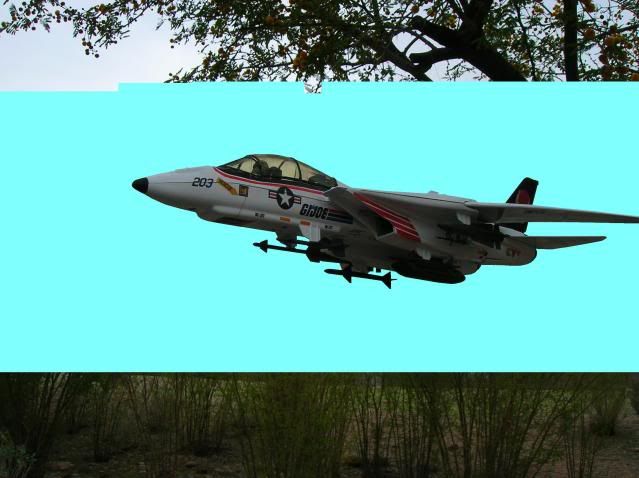 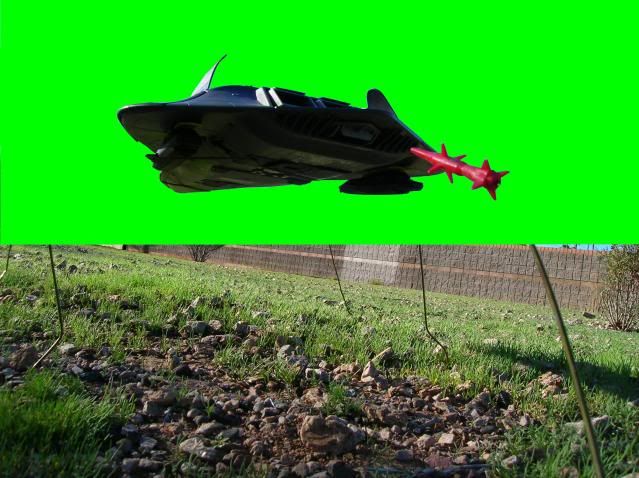 Now that you've got your plane cut out form the picture, you need to add a back ground to it. Here's where I've seen a lot of good pictures either go great or go bad. Take the time to go to Google or other search engines and look for back grounds of the sky, of mountains, of the ocean, of any and every landscape. Try to find some with differing light conditions, different times of day for different shadow angles. Choose some looking up into the sky from the ground, some looking down from the sky to the ground. I have a whole library of back ground images. Find what ever background you're looking for. Try to find one of a sufficient pixel size as well; the larger the better, that way your picture will look better. |
The reason I said to take pictures of your plane at different angles and in different lighting conditions is so that when you find these back ground pictures, you can match the shadows and lighting conditions better. Once you find a good back ground that matches your plane, go ahead and paste that sucker on there. Adjust the size of the plane so it looks good within the picture. Here's a couple of Rattlers were taken at as the sun was going down, so the lighting was perfct for this background.
 Something else to keep in mind when matching planes to back grounds is relativity. How does your plane sit relative to the back ground? Does it look natural or does it seem a bit off kilter. Planes move in three directions so if it's a bit crooked, it could look as if it's banking or something but does it have a weird angle to it that doesn't look right? This Night attack chopper looks OK here, but then again, it looks a little off because the angles don't match quite right 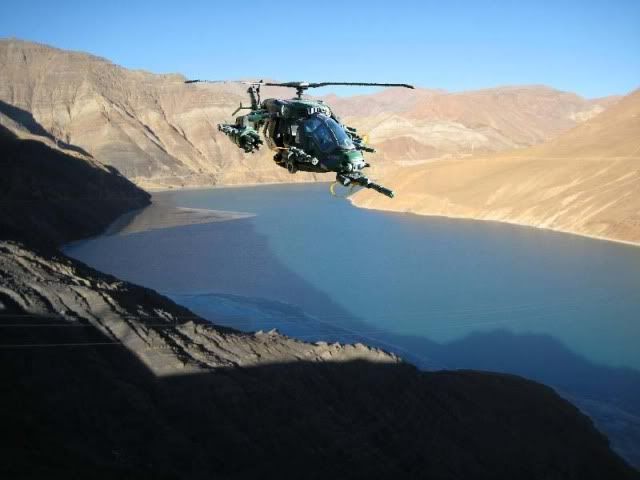 Here's a neat trick if you want more than one plane in the shot. First we have the Skystrikers again. This picture is done easily enough. I simply pasted the same picture of the plane twice, just making the background one smaller to make it look as if it's in the distance. Using the same plane twice also ensured that the lighting was the same on both planes, as well as their angle. 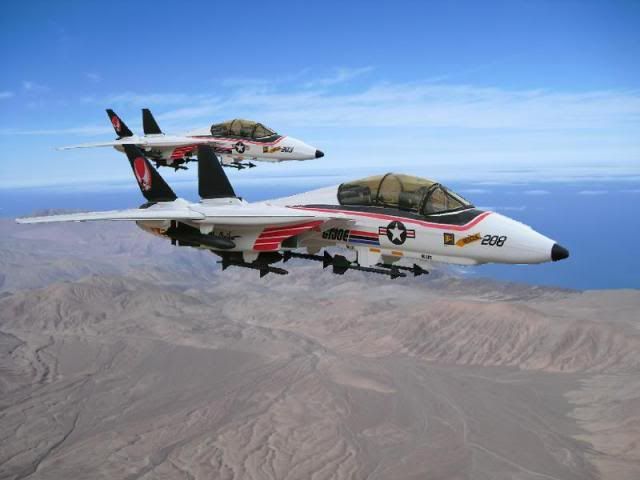 Now this shot has the Night Raven and a Conquest X-30 trailing it. That Conquest is actually right behind the Raven as the photo depicts, there is no cut and paste editing there. This simple trick was done by setting the planes on the ground in this position and cutting away the ground and their landing gear. Doing it this way again makes the lighting the same and the perspective the same. Nothing like having two planes that are supposed to be flying together have two different light sources and flight angles. 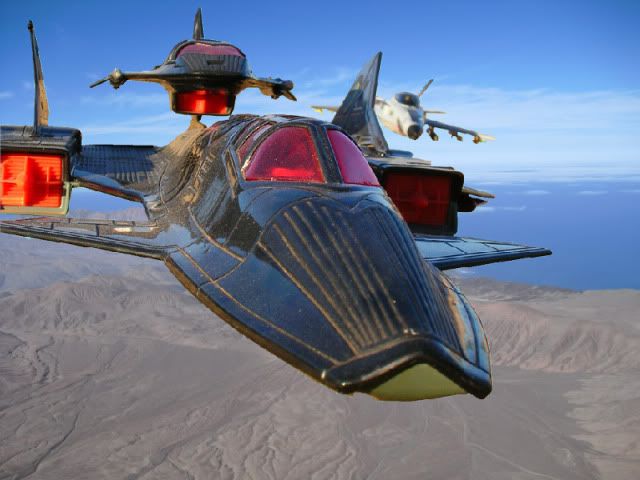 Notice, too, that between both pictures, I used the same background. Superimposing is all about the angle, blending in seamlessly, light sources and finding the right back ground. As far as special effects are concerned, I haven't quite mastered those yet, but if you play around with your photo editing programs, you can make the flames coming from the back end of a jet engine or missile or you can add some blur to a rotor blade if you don't like the way the real thing came out or you couldn't get the rotors to spin. I hope you found this tutorial helpful and if you guys have any questions, please feel free to shoot me a PM. |
 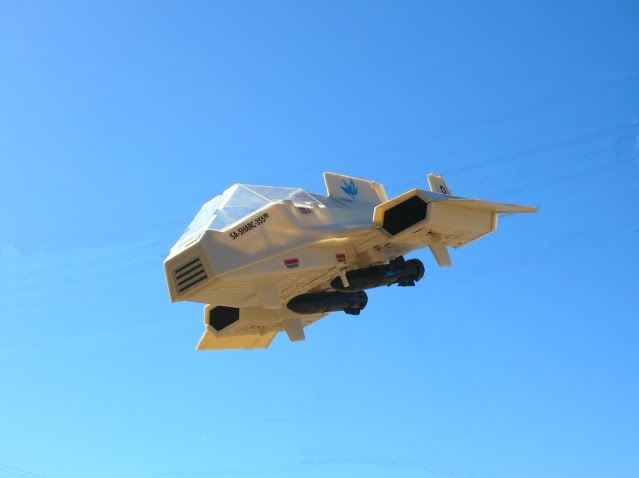 The effect on Serpentor's cape was achieved by sticking one of thsoe pain in the butt twist ties that hold vehicles into their pacakges into the back of his "skirt" an sticking it straight out. I formed a loop in the end so is held the cape in a more spread out look.  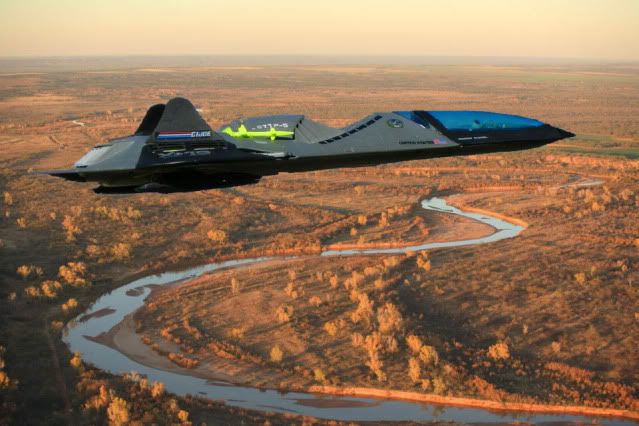 |
Cool stuff. Classic techniques.
The only problem I always have with this kind of thing, is that all my helicopters have dreadfully droopy rotors. Don't you have that ? I suppose it should be possible to put a piece of wire underneath them to have them angle up, as if carrying the weight of the chopper in flight, but I've never tried that. Has anyone ? |
very helpful. I had no idea on how to execute this. Just need to buy program now. Thanks!!!
|
| All times are GMT -7. The time now is 03:04 AM. |
Powered by: vBulletin Version 3.0.6
Copyright ©2000 - 2024, Jelsoft Enterprises Ltd.